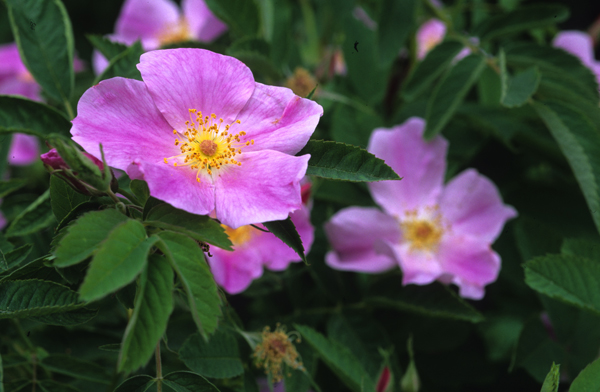Conservation
Native Alternatives to Exotic Trees, Shrubs and Vines

Illinois Rose (Rosa setigera) in bloom
JANUARY 17, 2023
“We have allowed alien plants to replace natives all over the country. Our native animals and plants cannot adapt to this gross and completely unnatural manipulation of their environment in time to negate the consequences. Their only hope for a sustainable future is for us to intervene to right the wrongs that we have perpetrated.”- Doug Tallamy, Entomologist, Ecologist and Conservationist
Many gardeners and landscapers are drawn to the unique beauty and variety of non-native plants, but the use of these exotic species can have negative impacts on local ecosystems. As awareness grows about the importance of conservation and protecting native species, more and more people are looking for alternative options that still provide a diverse and beautiful landscape. In this post, we will introduce you to some of the best native tree, shrub and vine alternatives to common non-natives.
You can find more information to help you properly ID these invasive plants by clicking on the link embedded in the Latin name.
Vines:
English Ivy (Hedera helix)
& Chinese bittersweet (Celastrus orbiculatus)
Native Alternatives:
American Bittersweet (Celastrus scandens)
Virginia Creeper (Parthenocissus quinquefolia)
Virgin’s Bower (Clematis virginiana)
Japanese Wisteria (Wisteria floribunda)
Native Alternatives:
American Wisteria (Wisteria frutescens)
Shrubs:
Butterfly Bush (Buddleia davidii)
Native Alternatives:
New Jersery Tea (Ceanothus americanus)
Buttonbush (Cephalanthus occidentalis)
Barberry (Berberis thunbergii)
Native Alternatives:
Eastern Wahoo (Euonymus atropurpeus)
Shrubby St. Johnswort (Hypericum prolificum)
Winterberry (Ilex verticillata)
Mapleleaf Viburnum, (Viburnum acerifolium)
Privets (Ligustrum sinense, Ligustrum japonicum)
Native Alternatives:
Red Chokeberry (Aronia arbutifolia)
Black Chokeberry (Aronia melanocarpa)
Gray Dogwood (Cornus racemosa)
Spicebush (Lindera benzoin)
Japanese Honeysuckle (Lonicera japonica)
& European Honeysuckle (Lonicera periclymerium)
Native Alternatives:
Dwarf Honeysuckle (Lonicera reticulata)
American Cranberry (Viburnum opulus var. americanum)
Arrowwood Viburnum (Viburnum dentatum)
Winterberry (Ilex verticillata)
Burning Bush (Euonymus alatus)
Native Alternatives:
Oak-leaf Hydrangea (Hydrangea quercifolia)
Fragrant sumac (Rhus aromatica)
Multiflora Rose (Rosa multiflora)
Native Alternatives:
Illinois Rose (Rosa setigera)
Prairie Rose (Rosa blanda)
Swamp Rose (Rosa palustris)
Autumn Olive (Elaeagus umbellata)
& Russian Olive (Elaeagus angustifolia)
Native alternatives:
Eastern Wahoo (Euonymus atropurpeus)
Maple Leaf Viburnum (Viburnum acerifolium)
Buttonbush (Cephalanthus occidentalis)
American Hazelnut/ Filbert (Corylus americana)
Trees
Empress Tree (Paulownia tomentosa)
Native alternatives:
Northern Catalpa (Catalpa speciosa)
Sassafras (Sassafras albidum)
Callery (Bradford) Pear (Pyrus calleryana)
Native Alternatives:
Red buckeye (Aesculus pavia)
Eastern Redbud (Cercis canadensis)
Wild Plum (Prunus americana)
Blue Beech (Carpinus caroliniana)
Silk Tree (Albizia julibrissin)
Native Alternatives:
Eastern Redbud (Cercis canadensis)
Flowering dogwood (Cornus florida)
Ironwood (Ostrya virginiana)
Amur Cork Tree (Phellodendron amurense)
Native Alternatives:
Kentucky Coffee tree (Gymnocladus dioicus)
Hackberry (Celtis occidentalis)
Norway Maple (Acer platanoides)
Native Alternatives:
Bur Oak (Quercus macrocarpa)
Shagbark Hickory (Carya ovata)
Kentucky Coffee tree (Gymnocladus dioicus)
[ez-toc]